从跨文化翻译视角看《聊斋志异》两个英译本
- 格式:pdf
- 大小:275.71 KB
- 文档页数:4
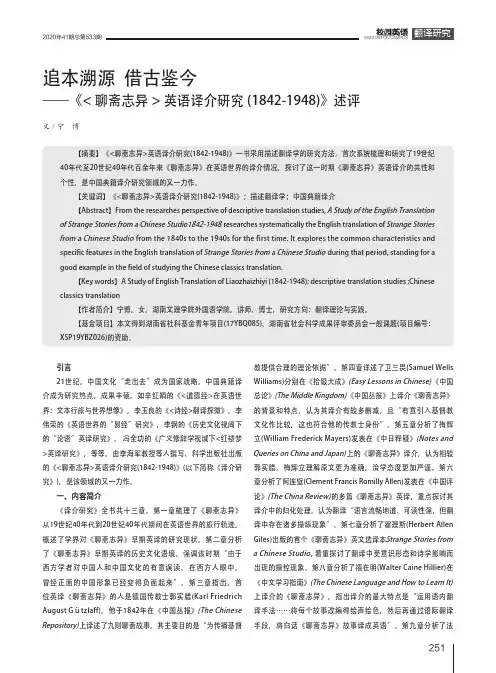
2512020年41期总第533期ENGLISH ON CAMPUS追本溯源 借古鉴今——《<聊斋志异>英语译介研究(1842-1948)》述评文/宁 博教提供合理的理论依据”。
第四章详述了卫三畏(Samuel Wells Williams)分别在《拾级大成》(Easy Lessons in Chinese)《中国总论》(The Middle Kingdom)《中国丛报》上译介《聊斋志异》的背景和特点,认为其译介有较多删减,且“有意引入基督教文化作比较,这也符合他的传教士身份”。
第五章分析了梅辉立(William Frederick Mayers)发表在《中日释疑》(Notes andQueries on China and Japan)上的《聊斋志异》译介,认为相较郭实腊,梅辉立理解原文更为准确,治学态度更加严谨。
第六章分析了阿连壁(Clement Francis Romilly Allen)发表在《中国评论》(The China Review)的多篇《聊斋志异》英译,重点探讨其译介中的归化处理,认为翻译“语言流畅地道、可读性强,但翻译中存在诸多操纵现象”。
第七章分析了翟理斯(Herbert Allen Giles)出版的首个《聊斋志异》英文选译本Strange Stories froma Chinese Studio , 着重探讨了翻译中受意识形态和诗学影响而出现的操控现象。
第八章分析了禧在明(Walter Caine Hillier)在《中文学习指南》(The Chinese Language and How to Learn It)上译介的《聊斋志异》,指出译介的最大特点是“运用语内翻译手法……将每个故事改编得绘声绘色,然后再通过语际翻译手段,将白话《聊斋志异》故事译成英语”。
第九章分析了法引言21世纪,中国文化“走出去”成为国家战略,中国典籍译介成为研究热点,成果丰硕。
如辛红娟的《<道德经>在英语世界:文本行旅与世界想像》,李玉良的《<诗经>翻译探微》,李伟荣的《英语世界的“易经”研究》,李钢的《历史文化视阈下的“论语”英译研究》, 冯全功的《广义修辞学视域下<红楼梦>英译研究》,等等。
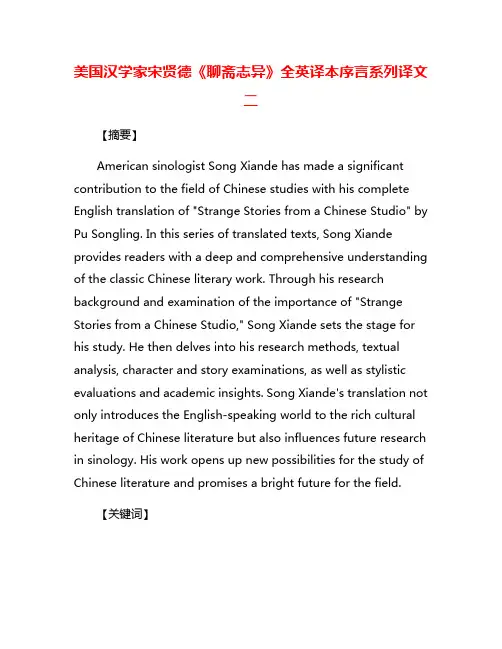
美国汉学家宋贤德《聊斋志异》全英译本序言系列译文二【摘要】American sinologist Song Xiande has made a significant contribution to the field of Chinese studies with his complete English translation of "Strange Stories from a Chinese Studio" by Pu Songling. In this series of translated texts, Song Xiande provides readers with a deep and comprehensive understanding of the classic Chinese literary work. Through his research background and examination of the importance of "Strange Stories from a Chinese Studio," Song Xiande sets the stage for his study. He then delves into his research methods, textual analysis, character and story examinations, as well as stylistic evaluations and academic insights. Song Xiande's translation not only introduces the English-speaking world to the rich cultural heritage of Chinese literature but also influences future research in sinology. His work opens up new possibilities for the study of Chinese literature and promises a bright future for the field.【关键词】汉学家,宋贤德,聊斋志异,全英译本,序言,研究背景,重要性,研究方法,文本解读,人物分析,故事分析,作品风格,学术研究,贡献,影响,未来展望。
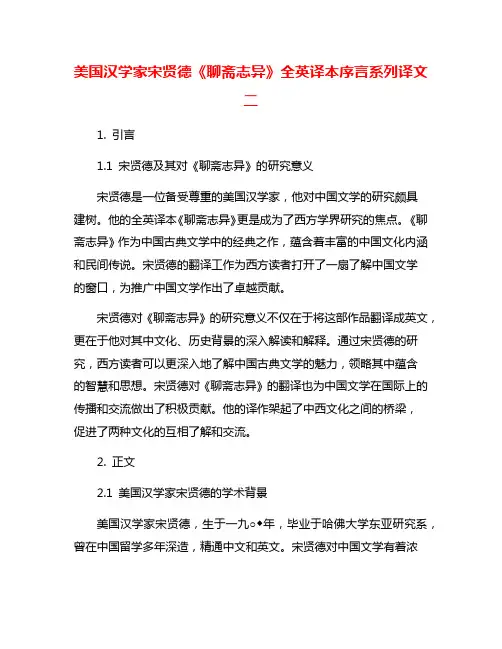
美国汉学家宋贤德《聊斋志异》全英译本序言系列译文二1. 引言1.1 宋贤德及其对《聊斋志异》的研究意义宋贤德是一位备受尊重的美国汉学家,他对中国文学的研究颇具建树。
他的全英译本《聊斋志异》更是成为了西方学界研究的焦点。
《聊斋志异》作为中国古典文学中的经典之作,蕴含着丰富的中国文化内涵和民间传说。
宋贤德的翻译工作为西方读者打开了一扇了解中国文学的窗口,为推广中国文学作出了卓越贡献。
宋贤德对《聊斋志异》的研究意义不仅在于将这部作品翻译成英文,更在于他对其中文化、历史背景的深入解读和解释。
通过宋贤德的研究,西方读者可以更深入地了解中国古典文学的魅力,领略其中蕴含的智慧和思想。
宋贤德对《聊斋志异》的翻译也为中国文学在国际上的传播和交流做出了积极贡献。
他的译作架起了中西文化之间的桥梁,促进了两种文化的互相了解和交流。
2. 正文2.1 美国汉学家宋贤德的学术背景美国汉学家宋贤德,生于一九○◆年,毕业于哈佛大学东亚研究系,曾在中国留学多年深造,精通中文和英文。
宋贤德对中国文学有着浓厚的兴趣,尤其热爱中国古典文学,他曾多次在学术期刊上发表关于中国文学的论文和研究成果,广受好评。
宋贤德研究的重心主要集中在中国经典文学作品的翻译和研究上,他曾对《红楼梦》、《水浒传》等著名作品进行过深入研究,被誉为西方汉学界的权威之一。
而《聊斋志异》作为中国古典文学中一部充满神秘和惊悚的作品,也吸引了宋贤德的注意。
宋贤德的学术背景扎实,对中国文学有着深厚的造诣,同时又具备优秀的翻译技巧和理解能力,这些优点使得他在研究和翻译《聊斋志异》这部作品时取得了显著成就。
宋贤德的学术背景为他的研究工作提供了坚实的基础,也赋予了他在西方汉学界的重要地位。
2.2 《聊斋志异》全英译本的历史意义宋贤德的《聊斋志异》全英译本在历史上具有重要意义。
这部作品为西方读者提供了一扇了解中国传统文学和文化的窗口。
通过这本书,西方读者可以深入了解中国民间传说、神话故事和超自然现象,从而增进对中国文化的理解和认识。

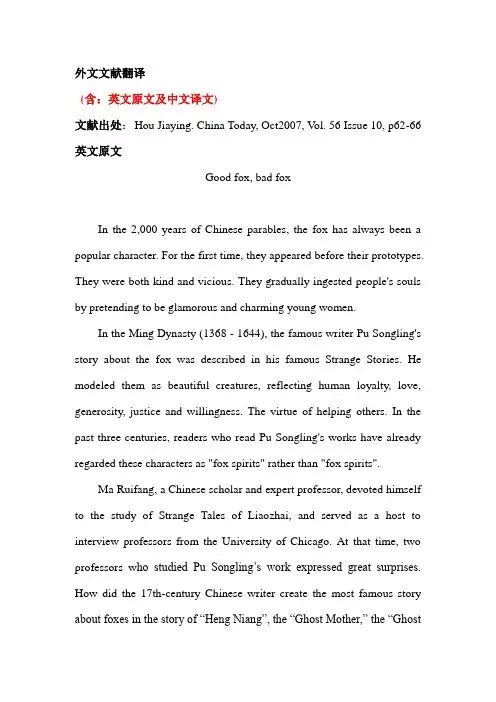
外文文献翻译(含:英文原文及中文译文)文献出处:Hou Jiaying. China Today, Oct2007, V ol. 56 Issue 10, p62-66 英文原文Good fox, bad foxIn the 2,000 years of Chinese parables, the fox has always been a popular character. For the first time, they appeared before their prototypes. They were both kind and vicious. They gradually ingested people's souls by pretending to be glamorous and charming young women.In the Ming Dynasty (1368 - 1644), the famous writer Pu Songling's story about the fox was described in his famous Strange Stories. He modeled them as beautiful creatures, reflecting human loyalty, love, generosity, justice and willingness. The virtue of helping others. In the past three centuries, readers who read Pu Songling's works have already regarded these characters as "fox spirits" rather than "fox spirits".Ma Ruifang, a Chinese scholar and expert professor, devoted himself to the study of Strange Tales of Liaozhai, and served as a host to interview professors from the University of Chicago. At that time, two professors w ho studied Pu Songling’s work expressed great surprises. How did the 17th-century Chinese writer create the most famous story about foxes in the story of “Heng Niang”, the “Ghost Mother,” the “GhostStory” of the 500 most-known stories in the Chinese society that was deeply rooted in the feudal system at that time. The implicit suggestion to his wife is that they should use women's tenderness to ensure that their spouse's passion is permanent, just as lawyers rely on American newspapers and magazines in the 1980s to seek out opposite-sex friends.The ideal world for womenThe plot in “Heng Niang” is a classic love of husband, wife and mistress. Heng Niang is a kind fox and is also a human wife. She has a neighbor called Hong Daye. Hong Dayi has one wife and one wife. The wife Zhu is far more beautiful than the little one, but she is only slightly older than her grandmother. However, to the surprise of Zhu, it is her husband Hong Kong that loves her. In the same way, Heng Niang’s husband also has a small sister, who is obviously younger and more beautiful than Heng Niang, but he still loves her wife deeply. When Zhu asked Hengniang why she was like this, Hengniang told her that it was human nature to abandon old things, pursue new things, craving for something that was not available and full of mysteries. At Hengniang's suggestion, Zhu will take a lenient and generous attitude towards her husband and sister-in-law over the next month, allowing them to spend days and nights together. Heng Niang also suggested that Chu should change her appearance. In the next month, try not to dress up, wear old clothes, and keep yourself busy with housework. But on the last day ofthe month, she will put on new clothes, new shoes, design a beautiful hairstyle, and dress herself up. Just as Heng Niang had expected, the light of love returned to the eyes of Hong Daye. When he saw Zhu, and before dusk came, he would knock Zhu's door. However, Zhu still complied with Hengniang's suggestion, using fatigue as an excuse to gently but firmly rejected him. The next day, she followed the same strategy. On the third day, the sun had not yet landed, and the great cause slipped into her room and waited for darkness. That evening, the couple had spent the happiest night since their wedding. Afterwards, when the great cause asked her if he could spend the evening with her, Zhu expressed opposition and told him that he must wait another three days before allowing him to enter the house again.Zhu is pleased to tell Hengnian that she has regained her great business success. Heng Niang told Zhu to continue to use the female tricks she taught her because although Zhu is very beautiful, she lacks femininity, so her husband’s passion is being revived and can only be short-lived. Heng Niang explained that charm includes a woman's lifestyle, various behaviors, such as the way she walks, the way she speaks, and even her husband's eyes. Heng Niang instructs Zhu on all proper female habits and tells her to practise herself in front of the mirror every day. In this case, of course, Zhu eventually won back the husband's loyal love. The charisma mentioned by Heng Niang was defined by thefamous writer and poet Luo Binwang of the Tang Dynasty (618-907) as “The Charm of Fox” 1,000 years ago. He created this word and gave it its hidden meaning in a prose about Empress Wu Zetian who convicted him. In any case, the Queen should feel honored, not provoked by this allusion.Another story about fox in “Ghost Stallion” - Jiaona. This story praises the sincere friendship and love between man and fox. When a young scholar, Kong Xueyu, became seriously ill, his friend, a fox, advised him to let his sister Jiaona cure him. A young woman whose image and way of doing things is like the grace of a willow, full of tenderness and dazzling wisdom, appearing around him. Jiao Na did a surgical operation for Conson and fed an elixir of elixir into his mouth. This medicine was depleted of her life energy and carefully cultivated. When Confucius resumed consciousness, he fell in love with the gentleness, quietness, beauty, and love of this young woman. Therefore, Confucius requested Jiao Na’s brother to marry her. However, because Jiaona was too young to marry, her family made her than her big sister Song Niang instead of her. Matsugami was as beautiful and kind as Jiaona, and the couple had lived a happy and happy life.A few years later, Kong's friend, fox cousin, told him that there was a thunderstorm that would come to their home and that they would all be destroyed unless Kong Sheng could rescue them. In spite of his ownsafety, Kong Xueyi immediately responded to his request. On that stormy night, Kong Shou held a sword and guarded the entrance to the cave where the fox family lived. Suddenly, a black whirlwind circled out of the hole and Jiaona was in the center of the hurricane. Confucius used his sword to make every effort to insert the black wind. In the end, Jiaona fell to the ground and was saved. As Kong’s help to her, Kong Sheng was attacked by lightning. Afterwards, the storm slowed down and the skies returned clear. The fox family was safe, but Conson was in danger. Jiao Na sacrificed the last elixir of life that had been made with a thousand years of practice and spit it in his long-lived mouth and once again saved him. With Persian's insistence, the fox family moved to live with him. In order to avoid more disasters, the fox family lived in seclusion in a quiet courtyard. The gate of the courtyard was only open to Kong Sheng and Song Niang. Several years later, Kong Sheng and So ng Niang’s children grew up, and he became a grey-haired old man. He maintained close friendship with the fox cousin and the married Jiaona and their family.Xiao Cui is another lovely fox story. Xiaocui is a very cute and lively fox, but her appearance is a pretty young lady. One day, her mother took her to the house of a surnamed family to steal. She seemed to want to abandon her daughter. The Wang family is a local family with a face, only one child, and it is a mentally retarded person. He was neither a playmate nor a man willing to marry him, but Xiao Tsui made a goodfriend with him and married him. Although Wang Jia first liked Xiao Cui, her unruly manner aroused their resentment. They often scolded and reprimanded her, but Xiao Cui quietly accepted this treatment. When Wang Wang was framed by his political opponents, Xiao Cui used her wisdom to save the whole family in dire straits. Moreover, she also cured her husband's mental illness. However, Xiaocui knew that her parents-in-law could never accept her rebellious attitude toward the feudal system at that time. She inadvertently discovered that a young woman looked like her and secretly arranged for her to replace him at the king’s house. Before secretly leaving, Xiao Cui admitted to her husband that she was actually a fox daughter. Several decades ago, her mother escaped the thunder robbery under Wang's robe. At that time, Wang was sheltering in a temple. Although Master Wang did not realize that he had given the fox mother help, she felt grateful for the reward she had at that time. It is for this reason that she left Xiaocui in her care.Evil foxRumors are often used to describe foxes. However, such clever and beautiful creatures are often described in ambiguity and humility. There is such an example in the rumors of "tiger tigers." This is an allegory of swindlers and rogues. It means that they will bend others to boast of their powerful power. Its origin was a story about the king of the Chu state two thousand years ago. The king asked his minister: "There are rumors thatthe northern princes are afraid of the Chu Ling Yin Zhao shirt. Is that really it?" His minister answered the king's question through a parable: The king of the forest tigers eat a When it just captured the fox, the fox told it: "You can't eat me because I have God's instructions and let me be the leader of the beast. If you don't believe me, then go with me through the forest and see if There are other animals that dare to block my path." The tiger agreed. Sure enough, all the animals fled far when they were close. The tiger does not understand that animals are afraid of it, not foxes, that they dare not eat foxes.Minister Jiang Yi continued to point out that the king’s territories cover an area of 2,500 square kilometers, and the military power has reached a million people. All of them are under the command of the Shojo shirt. The northern princes are undoubtedly afraid of the zhao yi shirts, but his position is as the king’s military power's controller and supreme imperial power. Jiang Yi warned that if the king is forced, his advantage will be weakened. Then the king gradually diluted Zhao's military power.The scolded foxShe is the leading actress in the "God List" and is a typical example of the evil fox. This Ming Dynasty literary work is about the story of the demise of the Shang Dynasty and the rise of the Zhou Dynasty. Yu Wang is the last monarch of Shang Dynasty and also a notorious tyrant. In thecommon people, he levies exorbitant taxes and exorbitant taxes to build a luxury palace for himself and live a life of levity. During his reign, the 600-year-old Shang Dynasty quickly disintegrated. The warfare of the embarrassment caused the people to lose their livelihoods and make the rule of the monarchy chaotic. In the "God List", the scorpion's nephew has been described as the culprit of the demise of the Shang Dynasty.She was a fox and she became beautiful. The image of the woman was sent to the palace to envy the king and overthrow the Shang Dynasty. Her reward is immortal.The king of Yu is very careless about the national affairs. He has given everything to his uncle. Bichon discovered his true face and urged the king to get rid of her, but it was useless. Not only that, but the king also was very angry with his uncle's reckless behavior and ordered the expulsion of Began. Having realized that the threat to her was greater than that of Gan Qi, he formulated a plan to kill the enemy. She pretended to be sick, and she deluded another king with a beauty, telling him that unless she had a heart to eat, she would die. Bichon was thus killed, but the evil of self-absorbedness surpassed that of her enemies. She was addicted to the love of unborn babies, and even encouraged the king to indulge in the gorgeous life of wine. All these have accelerated the demise of the Shang dynasty.She was eventually arrested and sentenced to death, but allexecutioners who were sent to execute the order were smitten by her charms and could not execute the order. After a few skilled butchers failed to perform their duties, a magical general ended his own life with his own hands.One of the main reasons for this novel is to explain why women's charisma is often equated with the evil fox, and why calling a woman fox is often regarded as an insult.Although there are all kinds of negative foxes, fox skin has always been widely praised. The earliest written reference was in the Book of Songs 2000 years ago. It wrote: "Use fur coats to make fur coats for our young princes." Fox coats are considered the only suit for nobles.The ancient Chinese tried every means to capture the fox's skin as much as possible, but since the fox was a very vigilant and very devious animal, hunting was usually just successful in making it vigilant. Humans have never successfully domesticated or reared foxes. It is one of the few animals that have enough intelligence to deceive humans.It may be a mixture of resentment and admiration, which has caused the Chinese literary world to describe it as an alternation of good and evil. The mythical encyclopedia of Mountain and Sea Classics and Geography Editing over 2000 describes the fox as a monster that has nine tails and special eaters. Shuo Wen Jie Zi (The principle of interpretation and study of characters), the first dictionary in Chinese history, created during theEastern Han Dynasty from 100 to 121 years ago, defines the fox as "a fascinating animal being devil-ridden."中文译文好狐狸,坏狐狸在中国两千多年的寓言中, 狐狸一直是受欢迎的角色。
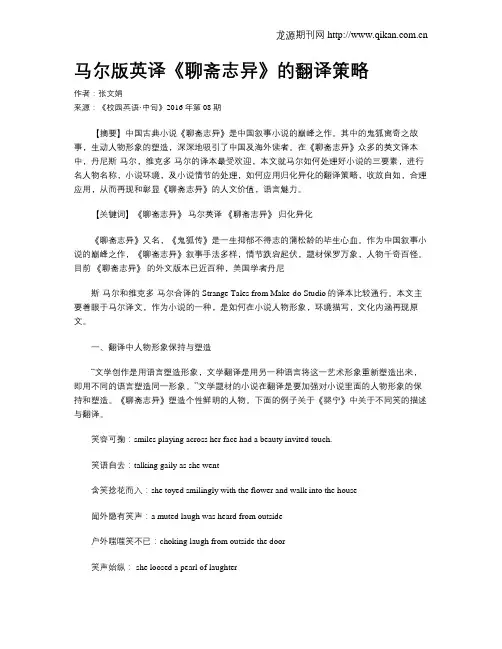
马尔版英译《聊斋志异》的翻译策略作者:张文娟来源:《校园英语·中旬》2016年第08期【摘要】中国古典小说《聊斋志异》是中国叙事小说的巅峰之作。
其中的鬼狐离奇之故事,生动人物形象的塑造,深深地吸引了中国及海外读者。
在《聊斋志异》众多的英文译本中,丹尼斯·马尔,维克多·马尔的译本最受欢迎,本文就马尔如何处理好小说的三要素,进行名人物名称,小说环境,及小说情节的处理,如何应用归化异化的翻译策略,收放自如,合理应用,从而再现和彰显《聊斋志异》的人文价值,语言魅力。
【关键词】《聊斋志异》马尔英译《聊斋志异》归化异化《聊斋志异》又名,《鬼狐传》是一生抑郁不得志的蒲松龄的毕生心血。
作为中国叙事小说的巅峰之作,《聊斋志异》叙事手法多样,情节跌宕起伏,题材保罗万象,人物千奇百怪。
目前《聊斋志异》的外文版本已近百种,美国学者丹尼斯·马尔和维克多·马尔合译的Strange Tales from Make-do Studio的译本比较通行。
本文主要着眼于马尔译文,作为小说的一种,是如何在小说人物形象,环境描写,文化内涵再现原文。
一、翻译中人物形象保持与塑造“文学创作是用语言塑造形象,文学翻译是用另一种语言将这一艺术形象重新塑造出来,即用不同的语言塑造同一形象。
”文学题材的小说在翻译是要加强对小说里面的人物形象的保持和塑造。
《聊斋志异》塑造个性鲜明的人物。
下面的例子关于《婴宁》中关于不同笑的描述与翻译。
笑容可掬:smiles playing across her face had a beauty invited touch.笑语自去:talking gaily as she went含笑捻花而入:she toyed smilingly with the flower and walk into the house闻外隐有笑声:a muted laugh was heard from outside户外嗤嗤笑不已:choking laugh from outside the door笑声始纵: she loosed a pearl of laughter孜孜憨笑而已:persisted in laughing giddily《聊斋志异》塑造了一个爱笑,天真烂漫的婴宁形象,译文中用:smile, laugh, gaily,muted laugh, choking laugh, pearl of laughter, laugh giddily 来表示各种笑态和欢乐。
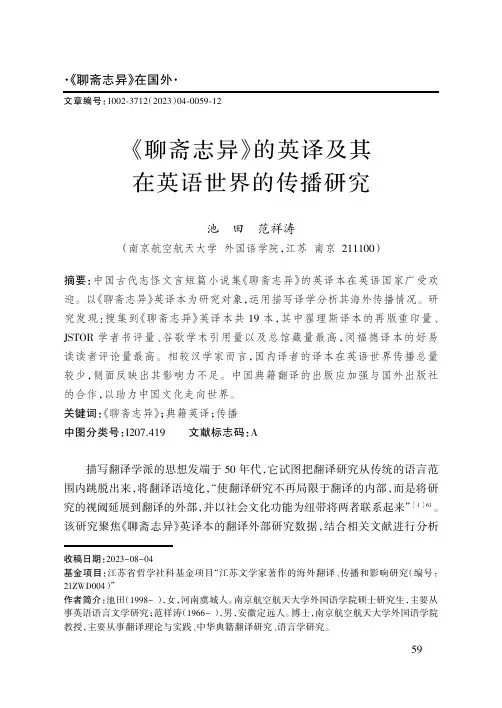
收稿日期:2023-08-04基金项目:江苏省哲学社科基金项目“江苏文学家著作的海外翻译、传播和影响研究(编号:21ZWD004)”作者简介:池田(1998-),女,河南虞城人。
南京航空航天大学外国语学院硕士研究生,主要从事英语语言文学研究;范祥涛(1966-),男,安徽定远人。
博士,南京航空航天大学外国语学院教授,主要从事翻译理论与实践、中华典籍翻译研究、语言学研究。
·《聊斋志异》在国外·文章编号:1002⁃3712(2023)04⁃0059⁃12《聊斋志异》的英译及其在英语世界的传播研究池田范祥涛(南京航空航天大学外国语学院,江苏南京211100)摘要:中国古代志怪文言短篇小说集《聊斋志异》的英译本在英语国家广受欢迎。
以《聊斋志异》英译本为研究对象,运用描写译学分析其海外传播情况。
研究发现:搜集到《聊斋志异》英译本共19本,其中翟理斯译本的再版重印量、JSTOR 学者书评量、谷歌学术引用量以及总馆藏量最高,闵福德译本的好易读读者评论量最高。
相较汉学家而言,国内译者的译本在英语世界传播总量较少,侧面反映出其影响力不足。
中国典籍翻译的出版应加强与国外出版社的合作,以助力中国文化走向世界。
关键词:《聊斋志异》;典籍英译;传播中图分类号:I207.419文献标志码:A描写翻译学派的思想发端于50年代,它试图把翻译研究从传统的语言范围内跳脱出来,将翻译语境化,“使翻译研究不再局限于翻译的内部,而是将研究的视阈延展到翻译的外部,并以社会文化功能为纽带将两者联系起来”[1]61。
该研究聚焦《聊斋志异》英译本的翻译外部研究数据,结合相关文献进行分析探讨,提出拓宽典籍英译传播广度的建议,以推动中国典籍的海外传播。
《聊斋志异》拥有众多外文译本,其中英译本广受欢迎。
然而,以此小说英译本研究为主题的文献并不多。
检索并整理文献发现,《聊斋志异》英译研究主体为国内学者,相关研究主要分为单个译本研究、译本对比研究、翻译史研究及研究综述,传播研究及影响研究并不多,且未见基于各类数据调查和科学框架为基础的传播研究。
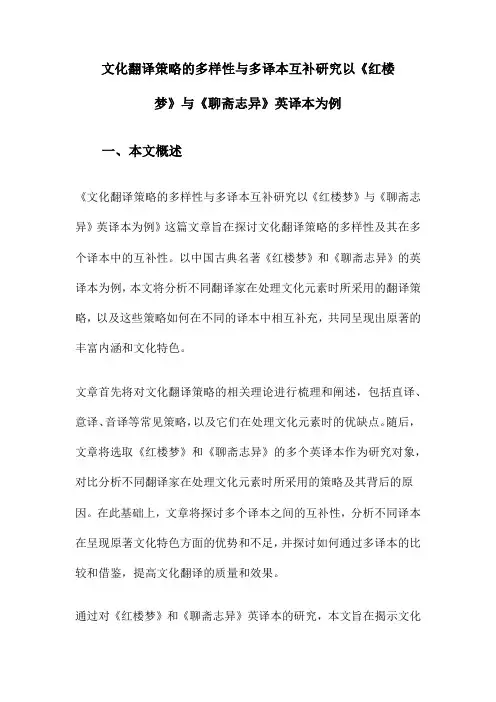
文化翻译策略的多样性与多译本互补研究以《红楼梦》与《聊斋志异》英译本为例一、本文概述《文化翻译策略的多样性与多译本互补研究以《红楼梦》与《聊斋志异》英译本为例》这篇文章旨在探讨文化翻译策略的多样性及其在多个译本中的互补性。
以中国古典名著《红楼梦》和《聊斋志异》的英译本为例,本文将分析不同翻译家在处理文化元素时所采用的翻译策略,以及这些策略如何在不同的译本中相互补充,共同呈现出原著的丰富内涵和文化特色。
文章首先将对文化翻译策略的相关理论进行梳理和阐述,包括直译、意译、音译等常见策略,以及它们在处理文化元素时的优缺点。
随后,文章将选取《红楼梦》和《聊斋志异》的多个英译本作为研究对象,对比分析不同翻译家在处理文化元素时所采用的策略及其背后的原因。
在此基础上,文章将探讨多个译本之间的互补性,分析不同译本在呈现原著文化特色方面的优势和不足,并探讨如何通过多译本的比较和借鉴,提高文化翻译的质量和效果。
通过对《红楼梦》和《聊斋志异》英译本的研究,本文旨在揭示文化翻译策略的多样性及其在多译本中的互补性,为今后的文化翻译实践提供有益的参考和启示。
本文也期望能够推动文化翻译研究的深入发展,为跨文化交流和文化传播做出积极的贡献。
二、文化翻译策略概述文化翻译,作为跨语言、跨文化的交流活动,其复杂性在于如何处理源语中的文化信息,使之在目标语中得以恰当、准确的再现。
在这一过程中,翻译策略的选择显得尤为重要。
翻译策略并非一成不变,而是根据文本类型、读者群体、翻译目的等多种因素灵活调整。
在文化翻译中,常见的策略包括直译、意译、音译、增译、减译等。
直译策略强调保留源语中的文化特色,尽可能字对字、句对句地翻译,以传达原文的异域风情。
这种策略有助于目标语读者了解源语文化的独特性,但也可能因为文化差异导致理解困难。
意译策略则更注重目标语读者的接受度,对原文进行适当调整,使之更符合目标语的表达习惯,但可能损失部分源语文化信息。
音译策略主要用于处理那些无法直译或意译的文化专有名词,如人名、地名等。
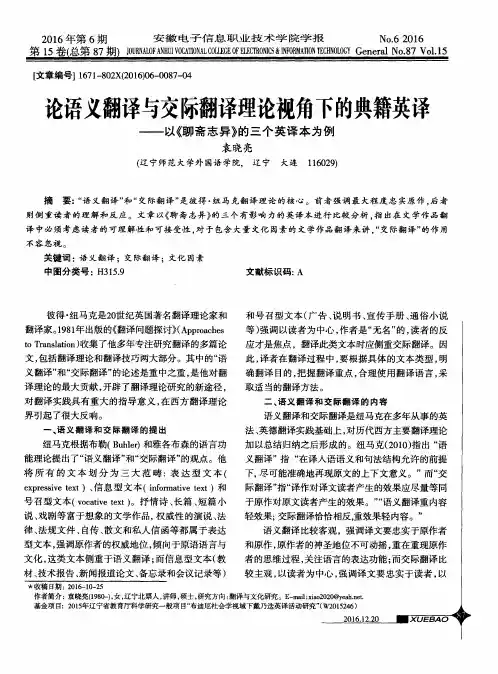
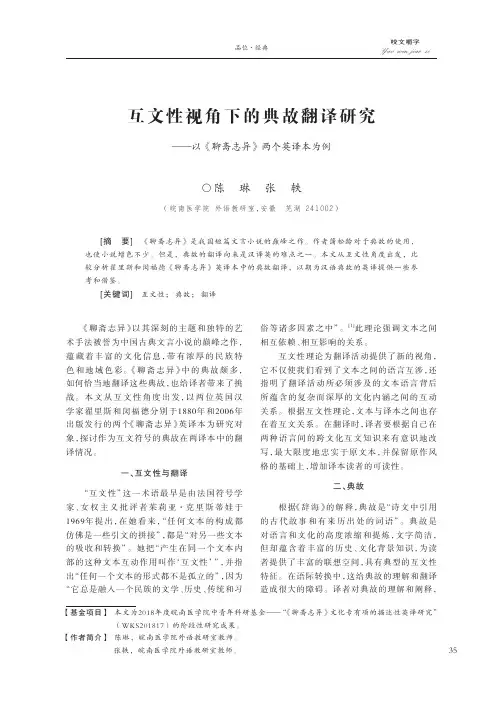
品位·经典35咬文嚼字Yao wen jiao zi【基金项目】 本文为2018年度皖南医学院中青年科研基金——“《聊斋志异》文化专有项的描述性英译研究” (WKS201817)的阶段性研究成果。
【作者简介】 陈琳,皖南医学院外语教研室教师。
张轶,皖南医学院外语教研室教师。
互文性视角下的典故翻译研究——以《聊斋志异》两个英译本为例○陈 琳 张 轶(皖南医学院 外语教研室,安徽 芜湖 241002)[摘 要] 《聊斋志异》是我国短篇文言小说的巅峰之作。
作者蒲松龄对于典故的使用,也使小说增色不少。
但是,典故的翻译向来是汉译英的难点之一。
本文从互文性角度出发,比较分析翟里斯和闵福德《聊斋志异》英译本中的典故翻译,以期为汉语典故的英译提供一些参考和借鉴。
[关键词] 互文性;……典故;……翻译《聊斋志异》以其深刻的主题和独特的艺术手法被誉为中国古典文言小说的巅峰之作,蕴藏着丰富的文化信息,带有浓厚的民族特色和地域色彩。
《聊斋志异》中的典故颇多,如何恰当地翻译这些典故,也给译者带来了挑战。
本文从互文性角度出发,以两位英国汉学家翟里斯和闵福德分别于1880年和2006年出版发行的两个《聊斋志异》英译本为研究对象,探讨作为互文符号的典故在两译本中的翻译情况。
一、互文性与翻译“互文性”这一术语最早是由法国符号学家、女权主义批评者茱莉亚·克里斯蒂娃于1969年提出,在她看来,“任何文本的构成都仿佛是一些引文的拼接”,都是“对另一些文本的吸收和转换”。
她把“产生在同一个文本内部的这种文本互动作用叫作‘互文性’”,并指出“任何一个文本的形式都不是孤立的”,因为“它总是融入一个民族的文学、历史、传统和习俗等诸多因素之中”。
[1]此理论强调文本之间相互依赖、相互影响的关系。
互文性理论为翻译活动提供了新的视角,它不仅使我们看到了文本之间的语言互涉,还指明了翻译活动所必须涉及的文本语言背后所蕴含的复杂而深厚的文化内涵之间的互动关系。
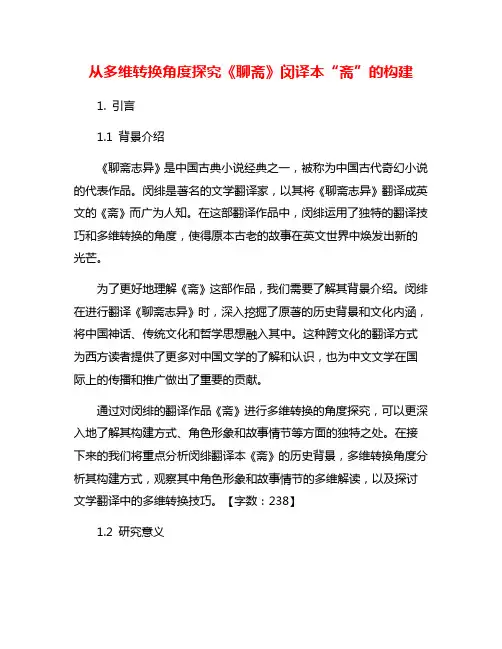
从多维转换角度探究《聊斋》闵译本“斋”的构建1. 引言1.1 背景介绍《聊斋志异》是中国古典小说经典之一,被称为中国古代奇幻小说的代表作品。
闵绯是著名的文学翻译家,以其将《聊斋志异》翻译成英文的《斋》而广为人知。
在这部翻译作品中,闵绯运用了独特的翻译技巧和多维转换的角度,使得原本古老的故事在英文世界中焕发出新的光芒。
为了更好地理解《斋》这部作品,我们需要了解其背景介绍。
闵绯在进行翻译《聊斋志异》时,深入挖掘了原著的历史背景和文化内涵,将中国神话、传统文化和哲学思想融入其中。
这种跨文化的翻译方式为西方读者提供了更多对中国文学的了解和认识,也为中文文学在国际上的传播和推广做出了重要的贡献。
通过对闵绯的翻译作品《斋》进行多维转换的角度探究,可以更深入地了解其构建方式、角色形象和故事情节等方面的独特之处。
在接下来的我们将重点分析闵绯翻译本《斋》的历史背景,多维转换角度分析其构建方式,观察其中角色形象和故事情节的多维解读,以及探讨文学翻译中的多维转换技巧。
【字数:238】1.2 研究意义研究闵译本《斋》的构建意义重大,不仅可以帮助我们更全面地了解这部经典作品,还可以深入探究文学翻译中的多维转换技巧。
通过分析闵译本的历史背景、构建方式以及角色形象和故事情节的多维转换,我们可以揭示出其中隐藏的文化内涵和美学价值,从而拓展我们对《聊斋》的理解。
研究闵译本还可以为文学翻译领域提供宝贵的案例和经验,有助于探讨如何在跨文化传播中灵活运用多维转换技巧,提高翻译质量和效果。
探究闵译本《斋》的构建对于加深我们对文学作品和翻译艺术的认识具有重要的意义,也为未来相关研究提供了新的思路和方向。
2. 正文2.1 闵译本《斋》的历史背景闵译本是中国文学史上的经典之作,而《聊斋》作为中国古典文学史上的一部重要作品,在历史上有着丰富的传承和发展。
闵译本《斋》诞生于20世纪,是近现代对《聊斋志异》的重要研究成果之一。
闵译本以其独特的翻译技巧和理论分析,将《斋》中的神怪故事和人物形象重新呈现于读者面前。
·《聊斋志异》在国外·文章编号:1002⁃3712(2023)04⁃0049⁃10《聊斋志异》民俗事象英译策略研究及对民俗交流的启示蒲艳春(青岛农业大学外国语学院,山东青岛266109)摘要:本文基于民俗学和翻译学理论,对《聊斋志异》英译本中精神民俗和社会民俗内容的英译策略展开研究。
研究表明,翟译本民俗事象英译以归化策略为主,宋译本以异化策略为主。
对民俗交流的启示如下:第一,译本翻译具有时代性,译本翻译策略的选择也具有时代性,译本更新要与时俱进,随时代发展不断完善和深入。
第二,译本翻译应注重思想性及对民俗内涵的挖掘与传达。
第三,要加强对英译本海外接受情况的研究,了解各译本在海外的接受度和满意度,总结成功译本的译介经验,助力民俗文化更有效地交流和传播。
关键词:《聊斋志异》;民俗事象;翻译策略;民俗交流中图分类号:I207.419文献标志码:A民俗,即民间风俗,指人民群众在社会生活中世代传承、相沿成习的生活模式,它是一个社会群体在语言、行为和心理上的集体习惯[1]4,是民众习得、传承和积累文化创造成果的一种重要方式。
[1]3因此,中国文化走出去,就要让中国的民俗文化走出去;让世界了解中国,就要让世界了解中国民俗文化的内涵。
收稿日期:2023-06-18基金项目:山东省艺术科学重点课题“山东民俗文化对外交流研究”(编号:ZH201906035)作者简介:蒲艳春(1980-),女,山东淄博人。
青岛农业大学外国语学院讲师,主要从事翻译理论与实践研究。
《聊斋志异》是一座民俗宝库,蒲松龄堪称研究民俗学的一大富矿。
[2]2我国的物质民俗、社会民俗、民俗信仰及民俗语言艺术等内容在《聊斋志异》中都有丰富的呈现。
作为优秀文学作品,其翻译对民俗文化对外交流传播有积极意义。
在中国知网数据库的主题或篇名或关键词字段中,包含“民俗文化翻译”的期刊文章有59篇,大部分文章都笼统探讨民俗文化翻译的方法。
目前未检索到结合《聊斋志异》探讨民俗文化翻译与传播的文章。
《聊斋志异》英译本中的伪翻译现象分析-应用语言学论文-语言学论文——文章均为WORD文档,下载后可直接编辑使用亦可打印——引言同《红楼梦》和《论语》等其它许多中国典籍一样,《聊斋志异》也不断被不同的译者翻译成英语,慢慢完成了其在英语世界的经典化过程。
19 世纪40 年代至20 世纪40 年代,是《聊斋志异》英译的第一次高峰时期。
在此期间,许多西方汉学家,如德国汉学家郭实腊和卫礼贤,美国汉学家卫三畏,英国汉学家梅辉立、禧在明、阿连壁和翟理斯,法国汉学家乔治苏利耶德莫朗等,为英语世界奉献了许多特色各异的《聊斋志异》英译文,为《聊斋志异》在英语世界的经典化作出了重要的贡献,其中翟理斯的两卷本Strange Stories from a Chinese Studio 更是自出版伊始就被公认为英语世界《聊斋志异》英译本的代表之作。
早期西方汉学家英译《聊斋志异》时处西强中弱的历史文化语境中,西方汉学家深受当时盛行的西方中心主义意识形态影响,翻译《聊斋志异》时会根据西方的意识形态、文化习惯以及自己的翻译目的对原文进行操纵,结果导致他们的《聊斋志异》英译中存在大量的伪翻译现象。
1 伪翻译伪翻译分为两种,一种是图里所指的那些无实际翻译操作过程,借翻译之名行创作之实的翻译( Toury,2001: 40) ; 一种是拉多所指的那些偏离原文太远而无法与之相提并论的翻译( MarkShuttleworth &Cowie Moria,2004: 134) 。
中外翻译史上,第一种伪翻译并不鲜见。
例如,中国古代佛经翻译史上存在大量伪翻译: 《清静心法经》、《巨力长者所问大乘经》、《本生心地观经》、《仁王经》等都是借翻译之名自创的伪经; 中国当代作家王山出版自己创作的畅销书《第三只眼睛看中国》时,声称该书是译自德国学者洛伊宁格尔的作品; 俄国文豪普希金发表诗歌《致李锡尼》时,声称译自某个古罗马诗人,其实该诗是他自己创作的作品; 法国作家皮埃尔路易出版《比利提斯之歌》时,声称该书译自希腊女诗人比利提斯的作品,不过后来人们发现《比利提斯之歌》是皮埃尔路易本人的创作。
2432020年30期总第522期ENGLISH ON CAMPUS生态翻译学视角下《聊斋志异》英译本的三维转换研究——以宋贤德译本为例文/吕 含篇章。
因而,本文除了分析《聊斋志异》中词语形式的文化专有项,也考虑到语音和句子层面的翻译难点,如文言文中的骈散句和对偶句。
二、文化专有项的分类文化的定义有百余种,其中奈达的文化分类被选为本课题的分类模式,因其兼顾了物质和意识形态两个方面,包括生态文化、社会文化、物质文化、宗教文化和语言文化五大类。
由于各民族生活的地理位置和生态环境的差异,生态条件也有不同的特点,具体表现在动物、植物、气候、方位等地理词汇上。
《聊斋志异》中的生态文化专有项大多包含隐喻或作委婉语使用,具有特殊含义,如动物类的“驽骀”和“豚儿”是古人用来自谦的词汇。
植物类的“细柳”用来形容女子纤细婀娜的姿态,而方位类的“北兵”实际上是指清兵。
社会文化包罗万象,存在于人们的日常生活和交际中,包括社会习俗、社会关系、行为习惯、社会阶层、 规章制度、生活方式、历史背景等。
《聊斋志异》中包括大量的社会文化专有项,如表示婚丧嫁娶习俗的“吉期”和“冰斧”,表示科举制度的“秀才”以及表示社交礼仪的“折柬”等等。
物质文化专有项指人们在日常生活中制造出来的物质实体,在《聊斋志异》中大多以建筑物、服饰、生活用品、乐器等名词来体现,如服饰类的“靴”,生活用品类的“几”,以及乐器类的“箫管”和“琵琶”。
宗教文化在奈达的分类中分为宗教传说和宗教信仰两部分。
儒家的“忠孝仁义”,佛家的“业满劫脱”,道家的“天师”和“葫芦”,甚至民间信奉的白莲教都是蒲松龄用以抨击当时黑暗社会的有力武器。
语言文化指一种语言在语音、词汇、句式、篇章等层面上的经典文学作品《聊斋志异》是清代著名小说家蒲松龄的著作,书中塑造了大量生动的狐仙、妖怪、鬼兽等形象,并借此表达对当时社会现实的不满,对社会的黑暗面进行了有力的批判,取得了中国文言小说的最高成就。
从翟理斯《聊斋志异》英译本看文学翻译中的译者主体性一引言翻译难,因为译者没有充分的自由。
在传统的翻译观念中,译者的身份被定位为“仆人”,译者被当做翻译中的语言符号的转换者,“戴着镣铐跳舞”。
作为翻译主体和世界文学创造者的译者一直没有得到应有的肯定和研究。
20世纪70年代翻译界出现了文化转向,译者的边缘化地位得到改变,译界越来越重视对译者的研究。
1990年苏珊•巴斯内特和安德烈•勒菲弗尔合编了《翻译、历史与文化》,首次正式提出翻译研究的“文化转向”问题,翻译研究便开始摆脱译作与原作二元对立的封闭、静态的体系,进入语境、历史和文化等宏观的境地,探讨影响整个过程的操控因素,译者的研究被提到了一个不可忽视的地位。
本文以现代阐释学为理论基础,通过分析翟理斯《聊斋志异》英译本,探讨文学翻译中的译者主体性问题。
二阐释学理论下的译者主体性阐释学,广义指对于文本之意义的理解和解释的理论或哲学。
该理论最初不是为翻译而发展起来的,只是对艺术作品的分析和阐释。
而译者在翻译时对原文本的解读、阐释及语言信息转换和对艺术作品的理解在许多方面相似,所以后来现代阐释学理论被用来指导翻译研究。
现代阐释学之父伽达默尔,完成了阐释学由古典形态向现代形态的转变,其《真理与方法》成为阐释学最有权威性的经典文献。
他认为,理解是以历史性的方式存在的,因为理解的主体――人和客体――文本都是历史存在的,都处在历史的发展演变之中。
读者都有自己的“前理解”,即之前的知识或经验视野,所以在理解活动中不可能完全揭示某一文本的原意,而总是带着理解者、阐释者自身的痕迹。
因此,“理解根本无法复制本文作者的原意”。
引入到翻译研究领域,看似为不可译论,但是理解的主体和客体都具有各自处于历史演变中的“视阈”,理解就是本文所拥有的诸多过去视界与主体视界的融合,称为“视界融合”,因此,翻译理解不是消极复制文本,而需要发挥译者主体性,进行一种创造性劳动,从而证明译者劳动的创造性价值。
The Spanish Version of Strange Tales of Liao Zhai and the Difference between Chinese and Spanish
Culture
作者: 古孟玄
作者机构: 国立政治大学欧文系,台湾11605
出版物刊名: 蒲松龄研究
页码: 57-71页
年卷期: 2014年 第4期
主题词: 文化翻译;文化元素;翻译策略
摘要:短篇小说集《聊斋志异》为清代蒲松龄的作品,全书共计12卷491篇。
民间有言蒲松龄将路人口传的故事记下,加以润饰成书,亦有学者指出此书既有作者原创,亦有民间传说,众说纷纭不一。
内容以谈论神仙狐鬼精魅为主,并以此反映康熙时期的社会状况。
根据香港中华文化研究院的分类,《聊斋志异》主题涵盖爱情故事、官场黑暗面、科场弊端、讽谕世情、异闻笔记等。
作者善于描述情境,文字细腻,正是作为反映中国人文物质文化的适切文本。
西班牙语版本之译者为La—ureano Ramirez Bellerin及Laura A.Rovetta,两位均有深厚的中文造诣。
16页的译序指出尽量减少注释,俾使译本更为平易近人,便于西语读者阅读。
本文藉由西语译本与原著的对照,从翻译技巧与策略的角度,探讨中西文化差异的面向,以及翻译的可能性。